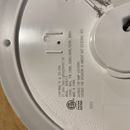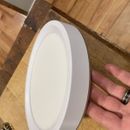Surface-Mount LED Lights in Cathedral Ceiling
Hello, I would like to install 2 of these lights in a Cathedral ceiling. I have read a few articles here saying not to install can lights due to issues with air leakage, heat generation leading to roof deck rot etc.
Wondering if this will be the sam issue with these surface mount. LED lights, they are 11 watts. My plan was to use a ceiling box (j-box?) seal all the penetrations in the box with a fire block caulk (i think I read an article here on that) then caulk the rim of the fixture to the drywall ceiling.
Any opinions on this approach, is it a bad idea? i am thinking that this LED light must generate less heat that a can light due to the low wattage and I think it would be air sealed fairly well.
GBA Detail Library
A collection of one thousand construction details organized by climate and house part











Replies
This is a better way to go than a can light, but there is still some risk. The general rule is "try not to put any holes in a catherdral ceiling since a good air barrier is vital there".
I would recommend using the white fiberglass "hard boxes" here since they don't have any holes or gaps -- there are just punch outs to use where the wire comes in. These style boxes are easier to air seal compared to the regular plastic or metal boxes that have lots of holes. I would use some red high-temperature silicone sealant (NOT intumescent fire stop caulk) to seal the electrical wire where it enters, and probably canned foam around the perimeter of the box.
Bill
Thanks Bill,
One thing I wanted to mention is that I am most worried about is causing any moisture issues and not too worried about any heat loss as far as energy efficiency goes.
Also should have mentioned that these will be in a bathroom
Mositure IS the bigger issue here. Air sealing helps with both though.
BTW, Kiley brought up a good point about trying other kinds of lighting. I wanted to comment on that since that's how I solve the problem too: I like to use reflective lighting in areas with cathedral ceilings, either from wall sconces or cove lights. New LED strips make all kinds of interesting cove lighting ideas possible. With reflective lighting all you need is a white ceiling, no need to mount any fixtures in the ceiling.
Bill
Thanks, so the condensation would come from the heat from the lamp to the cold air correct?
( btw, I am in Northern VT)
Would any air leaking come in to play as far as causing the condensation?
Totally going to look into other options but these lights generate a tiny bit of heat, i have one setup on a table face down with a jbox on it and has been on a few hours and i can barely detect any heat on the ceiling side, it is quite warm on the light side but suspect some of that is due to it being on the table with very little ventilation.
This is far from a scientific test and the jbox is not air sealed nor is the light mounted on the ceiling so the heat wouldn’t get trapped or build up so who knows. I would say that the light would generally never be on and when it is maybe 1/2 to 1 hr but to be fail safe one needs to know what of ot was left on 24/7.
It's not really about the heat of the light, it's about warm, moist indoor air going up through the holes by way of stack effect and then condensing on cold roof surfaces inside the ceiling. If you stop the airflow through the hole, you also stop the moisture migration that goes along with the air movement.
Bill
Thanks Bill for reply #7 )again no “reply” button available for some reason)
I think I will probably go ahead and install them, i can’t imagine I can’t get a good air seal on them, up lighting is not really an option because the ceiling is not very flat/smooth and their was mild popcorn that was skim coated and looks terrible when lit up but not even noticeable with wall lights and down lighting.
Hi Mark,
This is a good thread on the topic to read through: Properly Installed Can Light vs. Surface Mount. You’ll find some helpful resources mentioned there. Given the complexities of getting any kind of can light installation right (though you are right to think surface-mounted cans are a better bet in terms of air infiltration issues), I wonder if you have considered cabinet-top or cove lighting? Take a look at this article from lighting expert and educator David Warfel to get a sense of what can be accomplished outside of can lighting: LEDs Offer Flexibility for Home Lighting Design.
Thanks, I will take a look